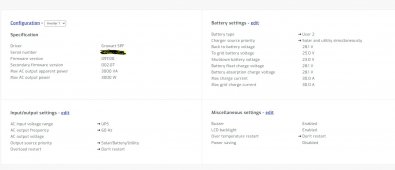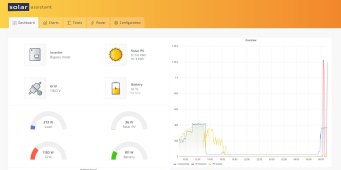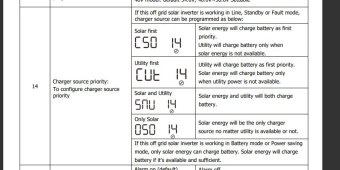Greetings, I want to share my experience with this unit in the hopes that someone can explain to me what is going on.
I run a YT chan called Unkyjoe's Playhouse, I am getting into solar and starting small with the goal of powering my studio racks and office with Solar and Battery backup.
The Growatt unit was a donation from a supporter of the channel. It is working, however it has some quirks I am trying to wrap my head around, I have tried these settings both through the front panel of the unit and through the Solar Assistant program as well.
I want the unit to switch to grid power when the battery voltage drops to 25v or less, I have 2 12v LIFEPO4 batteries, that were charged fully and separate from one another, then connected parallel for 24hrs to balance one another, they are working fine. Below are my settings for each item on the Growatt menu.
1-sbu, 2-30amps, 5-us2, 10-2, 11-50amp, 12-25v if I try and set this higher it jumps back to 25v, 13-28.5v, 14-snu, 19-28.8v, 20-28.8v, 21-23v, 22-sbe
When testing I set 12 to 26v to see if it would switch to grid and start charging the battery from the grid, it simply defaults back to 25v, this is with USE and US2 setting.
When switching to grid, and charging the battery I want it to charge the batt to 28.8 before switching back to battery, but I am confused if I need to set 13 to 28.8v as well as 19-20, the documentation is not clear on this and I wonder why this setting is there at all.
I reached out to Growatt directly and they had me update the firmware on the unit, but the instructions they sent are not clear and there is a language barrier with their support staff, I think the firmware was updated, however in the Solar Assistant software I see Firmware version 097.00 and a Secondary firmware of 2.07 which appears to be the version number they had me upgrade to.
I can change the above mentioned settings in the Solar Assistant program as well, however setting 12 which is "To grid battery voltage" wont go above 25v, it drops back down if you set it higher.
Settings 19-20 are float and absorption, but how does one trigger the battery charger to manually kick on, or is that even possible.
Any help or insight would be greatly appreciated.
Unkyjoe
I run a YT chan called Unkyjoe's Playhouse, I am getting into solar and starting small with the goal of powering my studio racks and office with Solar and Battery backup.
The Growatt unit was a donation from a supporter of the channel. It is working, however it has some quirks I am trying to wrap my head around, I have tried these settings both through the front panel of the unit and through the Solar Assistant program as well.
I want the unit to switch to grid power when the battery voltage drops to 25v or less, I have 2 12v LIFEPO4 batteries, that were charged fully and separate from one another, then connected parallel for 24hrs to balance one another, they are working fine. Below are my settings for each item on the Growatt menu.
1-sbu, 2-30amps, 5-us2, 10-2, 11-50amp, 12-25v if I try and set this higher it jumps back to 25v, 13-28.5v, 14-snu, 19-28.8v, 20-28.8v, 21-23v, 22-sbe
When testing I set 12 to 26v to see if it would switch to grid and start charging the battery from the grid, it simply defaults back to 25v, this is with USE and US2 setting.
When switching to grid, and charging the battery I want it to charge the batt to 28.8 before switching back to battery, but I am confused if I need to set 13 to 28.8v as well as 19-20, the documentation is not clear on this and I wonder why this setting is there at all.
I reached out to Growatt directly and they had me update the firmware on the unit, but the instructions they sent are not clear and there is a language barrier with their support staff, I think the firmware was updated, however in the Solar Assistant software I see Firmware version 097.00 and a Secondary firmware of 2.07 which appears to be the version number they had me upgrade to.
I can change the above mentioned settings in the Solar Assistant program as well, however setting 12 which is "To grid battery voltage" wont go above 25v, it drops back down if you set it higher.
Settings 19-20 are float and absorption, but how does one trigger the battery charger to manually kick on, or is that even possible.
Any help or insight would be greatly appreciated.
Unkyjoe






